13 Best Portable Weather Stations for Field Researchers to Track Weather on the Go
If you’re looking for the best portable weather stations for field research, I recommend checking out options like the Ambient Weather WS-2902, ECOWITT kits, or handheld meters that combine accuracy with ease of use. These devices offer real-time data on wind, temperature, humidity, and more, with wireless connectivity and durable designs for outdoor conditions. Keep exploring to find detailed reviews and features that help you choose the perfect tool for your environmental tracking needs.
Key TakeawaysThese portable weather stations offer comprehensive measurements, including wind, temperature, humidity, rainfall, UV, and solar radiation, ideal for field research.They feature wireless connectivity via Wi-Fi, Bluetooth, or radio, enabling real-time data sharing and remote monitoring.Designed with weatherproof, durable materials for outdoor use, supporting quick setup and minimal maintenance in remote environments.Many models support sensor expandability, smart home integration, and cloud platforms like Weather Underground for enhanced data analysis.They cater to outdoor researchers, storm trackers, environmental scientists, and outdoor enthusiasts needing reliable, portable weather data.Ambient Weather WS-2902 WiFi Smart Weather Station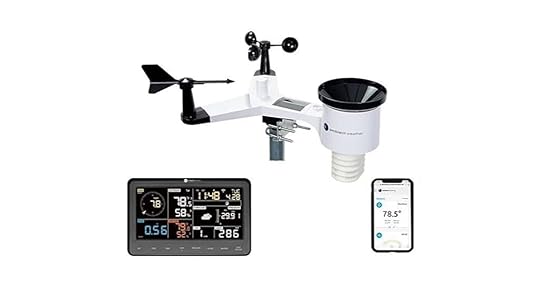
If you’re a field researcher who needs reliable, hyper-local weather data, the Ambient Weather WS-2902 WiFi Smart Weather Station is an excellent choice. It provides exhaustive measurements, including wind speed and direction, temperature, humidity, rainfall, UV, and solar radiation, all displayed on a clear color LCD. Setup is quick—mounting takes about five minutes—and it wirelessly transmits data to your devices via Wi-Fi. The station supports integration with smart home systems like Alexa and Google Home, making data access seamless. Its high accuracy and customizable alerts make it ideal for tracking weather conditions precisely in remote or outdoor environments.
Best For: outdoor enthusiasts, hobbyists, and field researchers seeking highly accurate, hyper-local weather data with smart home integration.
Pros:
Provides comprehensive measurements including wind, temperature, humidity, rainfall, UV, and solar radiation.Easy to set up and wirelessly transmits data via Wi-Fi with real-time updates.Compatible with smart home devices like Alexa, Google Home, and IFTTT for seamless data access.Cons:
Initial setup requires a Wi-Fi network with AP isolation turned off, which may need router adjustments.Some users experience delays or issues with data upload to Weather Underground due to outages.Minor hardware issues, such as screw difficulties or fragility, may occur during installation.Check PriceUrageuxy Wireless WiFi Weather Station with Wind Speed/Direction and Indoor/Outdoor Thermometer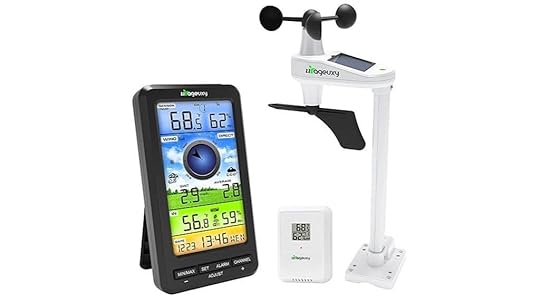
The Urageuxy Wireless WiFi Weather Station is an excellent choice for field researchers who need accurate, real-time environmental data on the go. It features multiple sensors, including wind speed, wind direction, and both indoor and outdoor thermometers, providing thorough weather insights. With Wi-Fi support, I can easily upload data to platforms like Weather Underground and WeatherCloud, enabling remote access and analysis. The bright 5-inch color display makes reading measurements simple, day or night. Setup is straightforward, and the device’s expandability with additional sensors lets me customize monitoring across various locations. It’s a versatile tool for tracking weather conditions anywhere I work.
Best For: field researchers and environmental enthusiasts who need accurate, real-time weather data remotely across multiple locations.
Pros:
Supports Wi-Fi connectivity for seamless data upload to popular weather platforms like Weather Underground and WeatherCloud.Features a bright 5-inch color display for easy reading day and night.Expandable with additional remote sensors to monitor multiple environments simultaneously.Cons:
Setup may require some technical familiarity despite being straightforward.Additional sensors are not included and must be purchased separately.Dependence on Wi-Fi connectivity may limit use in areas with unstable internet access.Check PriceECOWITT Weather Station Kit with Indoor Display and Outdoor Sensors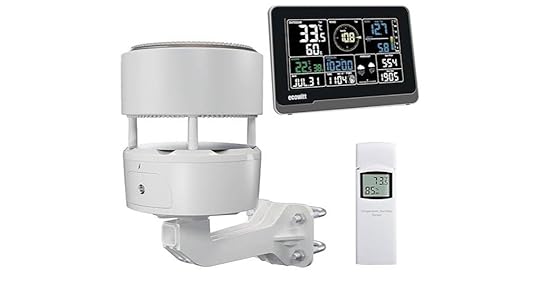
Designed for field researchers who need reliable, real-time weather data on the go, the ECOWITT Weather Station Kit offers an all-encompassing solution with its indoor display and outdoor sensors. It includes the WS3900 console with a clear 7.5-inch LCD that provides indoor temperature, humidity, and barometric pressure, plus the WS85 outdoor array with solar-powered sensors for wind, rainfall, and temperature. The system supports Wi-Fi for easy data upload to platforms like Weather Underground and WeatherCloud, and it can connect with up to 16 IoT devices for smart home integration. Its durability and expandability make it ideal for precise environmental monitoring in diverse conditions.
Best For: field researchers, weather enthusiasts, and smart home users seeking reliable, real-time environmental data with expandability and remote access.
Pros:
Highly accurate indoor and outdoor weather measurements with reliable sensors.Supports Wi-Fi connectivity for easy data upload and remote monitoring via popular weather platforms.Expandable with additional sensors and IoT devices for customized environmental monitoring.Cons:
Requires Wi-Fi setup and calibration, which may be complex for some users.Occasional Wi-Fi signal loss can result in missed data points, especially beyond 100 feet.Mounting and placement need careful consideration to prevent damage and ensure optimal sensor performance.Check PriceSainlogic Wireless Weather Station with Outdoor Sensor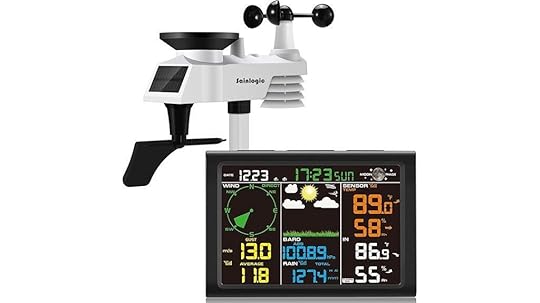
For field researchers who need reliable outdoor weather data, the Sainlogic Wireless Weather Station with Outdoor Sensor stands out thanks to its extensive monitoring capabilities and easy setup. It tracks real-time outdoor and indoor conditions, including rainfall, wind speed and direction, air pressure, humidity, and temperature. With a wireless range of up to 328 feet, it guarantees stable data transmission without messy wiring. The large LCD display with adjustable backlight makes reading metrics simple in any lighting. Plus, its alarm functions alert you to critical changes, helping you stay safe and informed during fieldwork. It’s a practical, user-friendly choice for accurate weather monitoring on the go.
Best For: field researchers and outdoor weather enthusiasts seeking reliable, real-time weather data with easy setup and comprehensive monitoring features.
Pros:
Extensive outdoor and indoor weather tracking including rainfall, wind, air pressure, humidity, and temperatureWireless range of up to 328 feet ensures stable data transmission without wiringLarge LCD display with adjustable backlight enhances readability in any lighting conditionCons:
May require initial calibration for precise measurements in specific environmentsLimited to the specified temperature and pressure ranges, which might not suit extreme conditionsSome users might find the alarm setup features complex or require time to customize thresholdsCheck PriceAmbient Weather Handheld Weather Meter with Windspeed, Temperature, Humidity, Dew Point, Heat Index, Pressure, Altitude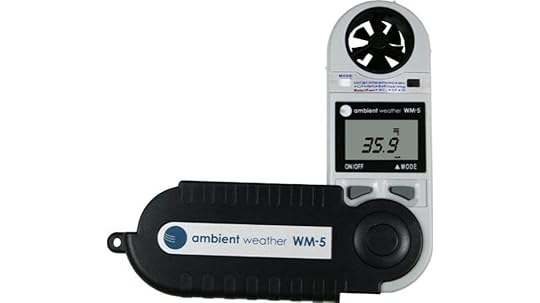
If you need a compact device that provides extensive weather data in real time, the Ambient Weather WM-5 Handheld Weather Meter is an excellent choice. It offers measurements for wind speed (up to 89 mph), temperature (F/C), humidity, dew point, heat index, pressure, and altitude, all in an ergonomic design. The device includes a soft case, neck lanyard, and a pocket-knife style cover for protection. Water-resistant and floatable, it’s suitable for storm tracking and outdoor activities. While its small display can be challenging to read in low light, the built-in flashlight helps. Regular calibration is necessary for accurate altitude readings, and battery life may be limited during extended use.
Best For: outdoor enthusiasts, storm trackers, and weather professionals needing portable, real-time weather data in a compact device.
Pros:
Provides comprehensive measurements including wind speed, temperature, humidity, dew point, and pressure.Water-resistant, floatable, and includes protective accessories like a soft case and cover for durability.Useful features such as pressure trend tracking and dew point measurement aid in storm monitoring and outdoor activities.Cons:
Small display can be difficult to read in low light conditions, despite the built-in flashlight.Altitude readings are often inaccurate without proper calibration, especially in mountainous regions.Battery life is limited, typically lasting only a couple of days with continuous use, requiring spare batteries.Check PriceTempest Weather System with Wind Meter and Alexa Integration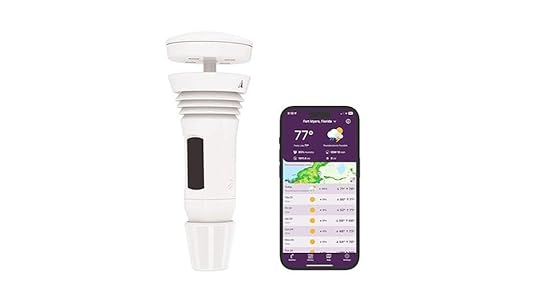
The Tempest Weather System with Wind Meter and Alexa Integration stands out for its seamless smart home compatibility, making it ideal for field researchers who want real-time weather updates integrated into their automated routines. It provides hyper-local data, monitoring temperature, humidity, wind speed, rainfall, lightning, and more, transmitting updates every 3 seconds wirelessly up to 1,000+ feet. Solar-powered and built with durable, no-moving-parts design, it’s easy to install and requires minimal maintenance. Its integration with Alexa and other platforms allows users to automate lighting, irrigation, and climate controls based on accurate, real-time weather data, enhancing field research efficiency.
Best For: field researchers and outdoor enthusiasts seeking highly accurate, real-time weather data integrated with smart home automation for precise environmental monitoring and automation.
Pros:
Provides hyper-local, real-time weather updates every 3 seconds with wireless transmission up to 1,000+ feet.Seamlessly integrates with Alexa, Rachio, IFTTT, and other smart platforms for automation of lighting, irrigation, and climate controls.Durable, solar-powered design with no moving parts, ideal for long-term outdoor use with minimal maintenance.Cons:
Requires WiFi connectivity for full functionality, which may be limited in remote field locations.Initial setup and integration may require technical knowledge or assistance.Advanced features and integrations may necessitate compatible smart home devices or subscriptions.Check PriceAcuRite Atlas Weather Station with Wi-Fi and Environmental Sensors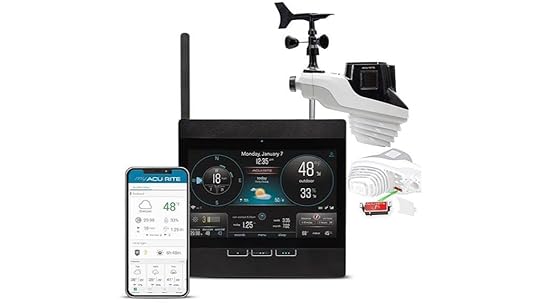
When tracking weather conditions in the field, precision and connectivity are essential, which is why the AcuRite Atlas Weather Station stands out. It measures over 20 data points, including temperature, humidity, wind, UV, light, pressure, and rainfall, offering detailed insights. Its advanced forecast combines elevation and pressure data for accurate 12-hour predictions, while lightning detection alerts you up to 25 miles away. The HD display is viewable from any angle, and an optional battery backup ensures data retention during outages. With Wi-Fi connectivity, you can monitor conditions remotely via your smartphone or desktop, making it ideal for outdoor use, research, or RV adventures.
Best For: outdoor enthusiasts, homeowners, and researchers seeking precise, real-time weather data with remote monitoring capabilities.
Pros:
Measures over 20 detailed weather data points including temperature, humidity, wind, UV, and rainfall.Utilizes patented self-calibrating technology for hyperlocal 12-hour weather forecasts.Supports Wi-Fi connectivity for remote access via smartphones and integration with Weather Underground.Cons:
Higher price point compared to basic weather stations.Requires Wi-Fi connection for remote features, which may be limiting in areas with poor internet.Setup and calibration may be complex for users unfamiliar with advanced weather equipment.Check PriceAcuRite Sportsman’s Weather Station with Hunting and Fishing Activity Meter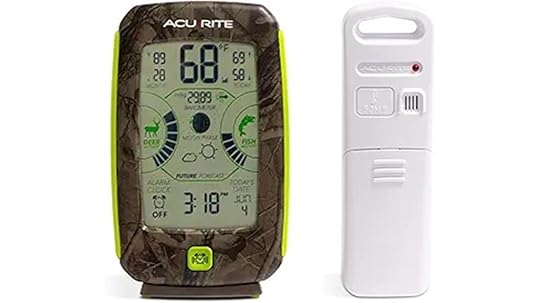
For outdoor enthusiasts focused on hunting and fishing, the AcuRite Sportsman’s Weather Station stands out with its specialized wildlife activity meter that combines weather data, moon phases, and barometric pressure. It provides hyperlocal 12-hour forecasts via a wireless outdoor sensor, along with real-time outdoor temperature, high/low records, and a weather-resistant LCD display. Its wildlife activity meter, more accurate than standard solunar calendars, helps predict animal movement based on environmental conditions. Designed for durability and easy outdoor placement, it’s powered by batteries and offers features like automatic clock updates and a built-in alarm, making it a valuable tool for planning outdoor activities.
Best For: outdoor enthusiasts, hunters, and fishers seeking accurate weather and wildlife activity data to optimize their outdoor activities.
Pros:
Combines weather forecast, moon phase, and barometric pressure for comprehensive wildlife activity predictionHyperlocal 12-hour forecast with wireless outdoor sensor for accurate outdoor weather dataDurable design with weather-resistant LCD display and easy placement optionsCons:
Requires batteries (not included) for both indoor and outdoor units, which may need frequent replacementForecast accuracy may vary, and a 14-day learning cycle is needed after battery replacementsSome users have experienced durability issues over many years, such as battery corrosion or unit failureCheck PriceHT.w Smart Temperature & Humidity Sensor with App Monitoring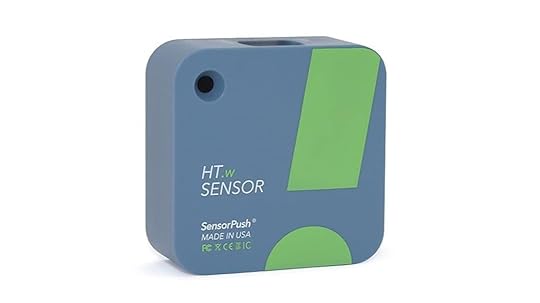
If you’re looking for a reliable way to monitor temperature and humidity remotely, the HT.w Smart Temperature & Humidity Sensor with App Monitoring stands out as an excellent choice. It’s compact, water-resistant, and features Bluetooth connectivity, making it versatile for various environments like greenhouses, RVs, or storage areas. The device records and logs data constantly, including dew point and VPD, with onboard storage for 45 days and unlimited in-app storage. Pair it with a WiFi Gateway for remote access and real-time alerts. Its durability, accuracy, and easy setup make it ideal for field researchers needing dependable, detailed environmental data on the go.
Best For: individuals and professionals seeking reliable, detailed remote monitoring of temperature and humidity in environments like greenhouses, storage units, RVs, and nurseries.
Pros:
Highly accurate and calibrated measurements for temperature, humidity, dew point, and VPDDurable, water-resistant design suitable for extreme conditions and long-term useEasy setup with Bluetooth connectivity and app interface for real-time alerts and data analysisCons:
Higher cost compared to some basic or less feature-rich alternativesRequires separate WiFi Gateway for remote access, adding to overall expense and setup complexityOccasional connectivity issues or internal faults have been reported by a few usersCheck PriceWireless Indoor Outdoor Weather Station with Atomic Clock and Humidity Monitor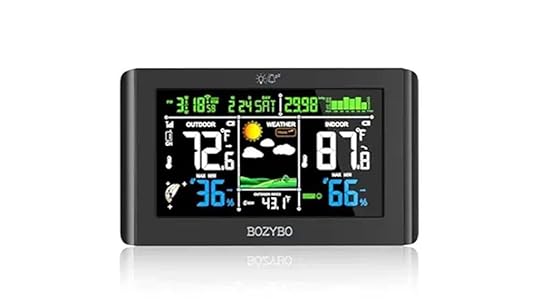
The Wireless Indoor Outdoor Weather Station with Atomic Clock and Humidity Monitor is an excellent choice for field researchers who need a detailed, easy-to-read display of environmental data. Its 7.5-inch HD color screen shows indoor and outdoor temperature, humidity, air pressure, moon phase, calendar, and weather forecast with trend icons. The device supports up to three remote sensors and features an atomic clock synced via WWVB radio, ensuring precise time. With adjustable backlight and simple setup, it’s user-friendly. While sensor pairing can occasionally be inconsistent, the large graphics and extensive info make it ideal for monitoring climate conditions on the go, especially in remote locations.
Best For: field researchers and outdoor enthusiasts needing comprehensive, easy-to-read environmental data with accurate timekeeping in remote locations.
Pros:
Large, colorful HD display provides clear, detailed environmental information at a glance.Atomic clock ensures precise time synchronization via WWVB radio signal.Supports up to three remote sensors for monitoring multiple indoor or outdoor locations simultaneously.Cons:
Sensor pairing may be inconsistent, leading to occasional connection issues.Weather forecast accuracy improves only after 7-10 days of data collection.Setup and initial synchronization can take up to a week, requiring patience and manual adjustments.Check PriceOBET Wireless Weather Station with 3 Sensors and Alerts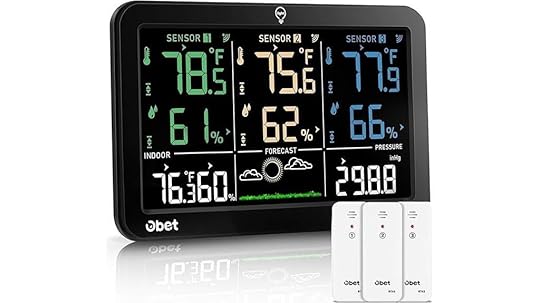
The OBET Wireless Weather Station with 3 Sensors and Alerts stands out for field researchers needing reliable, long-range environmental monitoring without relying on internet connectivity. Its 7.87-inch color LCD displays indoor and outdoor temperature, humidity, air pressure, and weather forecasts. The three weatherproof sensors communicate up to 500 feet away, covering multiple locations like gardens or garages. Adjustable brightness and USB power guarantee visibility and convenience. With high-accuracy sensors, trend indicators, and alert alarms for temperature and humidity extremes, it provides real-time data essential for research. Its simple setup and sturdy design make it an excellent portable choice for monitoring environmental conditions on the go.
Best For: field researchers and outdoor enthusiasts seeking reliable, long-range environmental data monitoring without internet dependency.
Pros:
Up to 500-foot wireless range with weatherproof sensors for flexible placement across multiple locationsHigh-accuracy measurements for temperature (+/-1.8℉), humidity (+/-5%), and air pressure, ensuring reliable dataClear, adjustable 7.87-inch color LCD display with trend indicators and easy setup for quick deploymentCons:
Sensors typically require AA batteries, which may need frequent replacement depending on usage and climateNo internet or app integration, limiting remote monitoring capabilities beyond local displayLimited customization options such as sensor labeling or advanced alert settingsCheck PriceGeevon Wireless Indoor Outdoor Weather Station with Dew Point and Touch LCD Display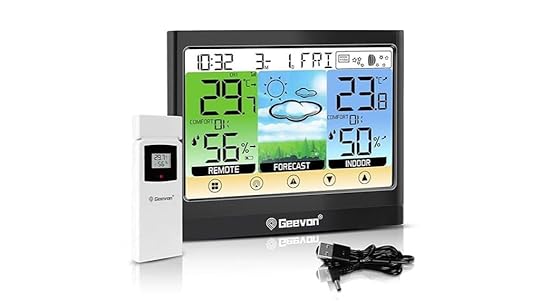
For field researchers needing precise environmental data on the go, the Geevon Wireless Indoor Outdoor Weather Station stands out with its large, easy-to-read touchscreen LCD display. The 5.9-inch color screen offers clear visibility of indoor and outdoor temperature, humidity, dew point, and weather forecasts up to 24 hours ahead. Its adjustable backlight guarantees readability in various lighting conditions. Supporting up to three wireless sensors within 200 feet, it monitors multiple locations like gardens or garages. Additional features include high/low alerts, dew point readings, mold risk indicators, and an alarm clock. Its versatile design supports wall mounting or tabletop use, making it ideal for on-the-move environmental monitoring.
Best For: field researchers, outdoor enthusiasts, and homeowners seeking precise, real-time environmental data across multiple locations.
Pros:
Large 5.9-inch color touchscreen for clear, easy-to-read displays of all data pointsSupports up to three wireless outdoor sensors within 200ft, enabling monitoring of multiple areasFeatures dew point, mold risk indicators, and customizable high/low alerts for comprehensive environmental managementCons:
Only one outdoor sensor included; additional sensors must be purchased separatelyRequires USB power, which may limit placement options without nearby outletsThe device’s size and features may be more than needed for casual or infrequent usersCheck PriceWiFi Weather Station with Indoor/Outdoor Thermometer and Rain Gauge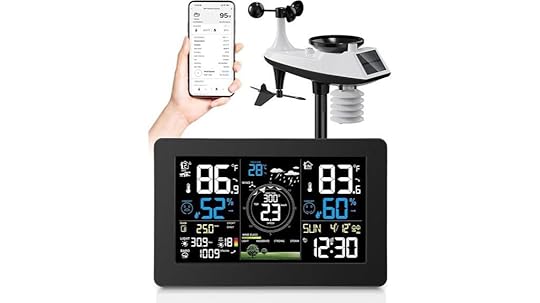
A WiFi weather station with an indoor/outdoor thermometer and rain gauge stands out as an ideal choice for field researchers who need real-time, all-encompassing weather data at their fingertips. Its large 7.5-inch HD display offers clear readings of temperature, humidity, wind speed, rainfall, pressure, UV index, and forecasts, with adjustable brightness for any lighting. Wireless connectivity with smartphones allows remote monitoring, data logging, and alerts. Equipped with professional-grade sensors and remote units powered by solar or batteries, it provides precise, instant updates. Its intuitive app and easy setup make it a versatile tool for outdoor research, gardening, or scientific projects on the go.
Best For: outdoor researchers, gardeners, and scientific professionals needing real-time, comprehensive weather data with remote monitoring capabilities.
Pros:
Large 7.5-inch HD display with adjustable brightness for clear visibility in different lighting conditionsSupports multiple remote sensors with professional-grade accuracy for wind, rainfall, UV, and other weather parametersWiFi connectivity with smartphone app for remote access, data logging, and customizable alertsCons:
Requires an AC/DC power adapter or solar power; batteries are not included, which may add extra cost or inconvenienceLimited to 2.4GHz WiFi networks, potentially restricting compatibility in some environmentsThe product’s size and weight (14.7×5.7×9.4 inches; 3.73 pounds) may not be suitable for very compact or portable setupsCheck PriceFactors to Consider When Choosing Portable Weather Stations for Field Researchers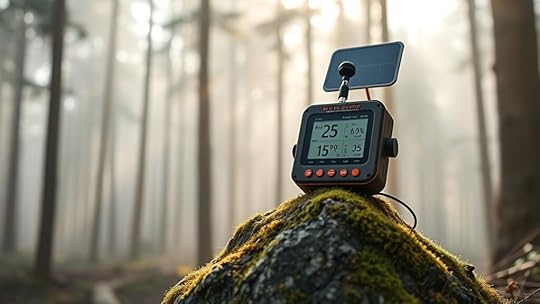
When selecting a portable weather station, I focus on key factors that impact performance and usability. Things like measurement range, accuracy, battery life, and durability are essential to get reliable data in the field. Considering sensor expandability and data sharing options also helps me choose a device that suits my specific research needs.
Measurement Range and AccuracyChoosing a portable weather station requires careful attention to its measurement range and accuracy to guarantee reliable data in your specific environment. I look for sensors that cover the necessary ranges, like temperatures from -50°C to 60°C or wind speeds up to 100 mph, to ensure the device suits my conditions. Accuracy specifications matter too; I prefer models with temperature accuracy within ±0.5°C, humidity within ±3%, and wind speed within ±2% of the reading, for dependable results. I also check if the device allows manual calibration to match local conditions, enhancing precision. Additionally, resolution—such as 0.1°C for temperature or 1 km/h for wind speed—is essential for detailed data. Lastly, error reporting features help me identify and correct inaccuracies during field use, guaranteeing data integrity.
Battery Life and PowerExtended battery life is crucial for field researchers who need uninterrupted data collection in remote locations. A device with longer battery life means fewer disruptions, reducing the need for frequent recharging or battery replacements. Power options like rechargeable batteries, solar panels, or AC adapters can markedly extend operational hours and minimize downtime. The battery capacity and consumption rates depend on factors such as sensor complexity, display features, and data transmission frequency. Devices with low power consumption modes can further prolong battery life during extended field studies. Regular calibration and maintenance of power sources are essential to prevent data gaps caused by power failures. When choosing a weather station, prioritize those with versatile power options and efficient energy use to ensure reliable performance in challenging environments.
Sensor Expandability OptionsSensor expandability plays a key role in customizing portable weather stations to meet specific research needs. By adding sensors like wind, rain, soil moisture, or UV, I can tailor the station to monitor multiple environmental parameters accurately. The number and compatibility of these sensors vary; some models support up to 16 sensors, providing extensive data collection. It’s important to contemplate communication protocols such as 915 MHz, 868 MHz, or Wi-Fi, as they influence sensor integration and range. The ability to add sensors after initial setup offers flexibility for long-term projects, allowing upgrades without replacing the entire system. This expandability enhances data accuracy and resolution, enabling multi-point measurements across different locations, which is crucial for detailed environmental analysis.
Data Connectivity and SharingReliable data connectivity is essential for field researchers who need real-time environmental information. I look for weather stations with options like Wi-Fi, Bluetooth, or radio frequencies such as 915 MHz or 433 MHz to guarantee seamless data transmission. The ability to upload data to cloud platforms like Weather Underground or custom servers allows me to access and analyze information remotely, which is critical when working across multiple locations. Many stations support multi-sensor networks, making it easy to expand data collection without losing integration. Stable, long-range wireless communication—up to several hundred feet—keeps data flowing even in challenging outdoor environments. Compatibility with mobile apps and web interfaces enhances setup, monitoring, and sharing, keeping my team connected and informed at all times.
Durability and WeatherproofingWhen choosing a portable weather station for field research, durability and weatherproofing are essential to guarantee accurate data collection in harsh conditions. I look for devices with an IP65 rating or higher, ensuring they resist dust and water exposure. Features like sealed enclosures, corrosion-resistant materials, and gasketed ports protect sensitive sensors and electronics from rain, snow, and dust. Materials such as stainless steel, high-grade plastics, and rubberized covers boost resistance to UV rays, extreme temperatures, and moisture. The sensors should be rated for outdoor use, reliably functioning in wind, rain, and temperature swings from -40°C to +60°C. Additionally, robust mounting options and shock-absorbing features prevent damage from impacts or vibrations, helping the device withstand the rigors of field environments.
Ease of SetupChoosing a portable weather station that’s easy to set up can guarantee you valuable time in the field and guarantee you start collecting accurate data quickly. Look for models with straightforward setup processes that take just minutes, without the need for special tools or technical expertise. Clear, detailed instruction manuals or quick-start guides make initial configuration and sensor calibration simple. Wireless options like Wi-Fi or Bluetooth should connect effortlessly, reducing troubleshooting. Devices with modular components or plug-and-play sensors allow for quick assembly and reconfiguration in different environments. Additionally, user-friendly interfaces and minimal hardware adjustments help ensure rapid deployment and ease of use outdoors. Prioritizing these features means you’ll spend less time on setup and more time gathering essential weather data.
Frequently Asked QuestionsHow Durable Are Portable Weather Stations in Extreme Weather Conditions?Portable weather stations are generally quite durable, especially those designed for field research. I’ve found that high-quality models are built with rugged materials and sealed to withstand extreme weather like heavy rain, snow, and strong winds. However, their durability can vary, so I always check the specifications. Proper maintenance and careful handling also help guarantee they perform well over time, even in challenging conditions.
Can These Devices Operate Effectively in Remote Locations Without Internet Access?I’ve tested many portable weather stations, and yes, they can operate effectively in remote locations without internet access. These devices often come with built-in data storage and wireless capabilities, allowing me to collect and store data locally. I’ve found that their independence from internet connectivity makes them reliable for fieldwork, ensuring I get accurate weather readings even in the most isolated areas, which proves that technology truly adapts to our needs.
What Is the Battery Life and Power Source Options for Field-Use Weather Stations?Battery life varies depending on the model, but most portable weather stations last between 8 to 24 hours on a single charge. Many use rechargeable batteries, often lithium-ion, which can be powered via USB or AC adapters. Some also offer solar panels as an eco-friendly option for extended field use. I recommend choosing a device with versatile power options to guarantee reliable operation during long outings.
How Accurate Are Portable Weather Stations Compared to Professional Meteorological Equipment?Portable weather stations can be surprisingly accurate, often within 1-2 degrees Celsius for temperature and 5-10% for humidity, comparable to some professional equipment. I’ve found that while they excel in mobility and quick readings, they may not replace high-precision meteorological tools for detailed analysis. So, if you need on-the-go data, they’re reliable, but for critical forecasts, professional-grade equipment still leads the way.
Are There Any Compatibility Issues With Smartphone Apps Across Different Device Brands?Compatibility issues with smartphone apps vary depending on the device brand and operating system. I’ve found that most portable weather stations work seamlessly with both iOS and Android, but some features may be limited on certain devices. To avoid surprises, I recommend checking the app’s compatibility list before purchasing. I always verify my device’s software is up-to-date for smooth operation and full functionality.
ConclusionAs I pack my weather station into my bag, I realize how these compact devices turn every outdoor moment into a clear story of the sky. Whether tracking wind whispers or raindrop rhythms, they feel like my personal weather whispers, guiding me through nature’s unpredictable dance. With the right station in hand, I’m always ready to read the sky’s secrets—no matter where my research takes me, I’m connected to the weather’s quiet language.



